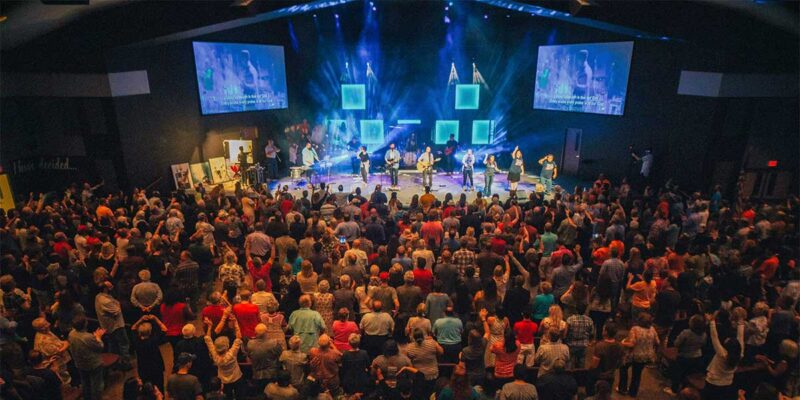Church Video Venues in High Demand
 When churches realized the value of video had also intersected with high brightness and low cost, the multi-site and satellite campus model went from a handful of mega churches (churches with greater than 2,000 in weekend attendance) to tens of thousands of churches. With this exponential explosion of multi-site churches — that is, a separate venue utilized as another service style option or for more seating capacity — manufacturers and systems integrators have key sales opportunities for entirely new audio, video and lighting systems to make these venues a reality.
When churches realized the value of video had also intersected with high brightness and low cost, the multi-site and satellite campus model went from a handful of mega churches (churches with greater than 2,000 in weekend attendance) to tens of thousands of churches. With this exponential explosion of multi-site churches — that is, a separate venue utilized as another service style option or for more seating capacity — manufacturers and systems integrators have key sales opportunities for entirely new audio, video and lighting systems to make these venues a reality.
I have identified four types of church video venues; each represents an ever-increasing substantial technology deployment and greater sales opportunities for those firms willing to address this high-growth segment of the house of worship market.This is the stunning opportunity of church video venues in high demand.
Type 1 – Overflow Video Venue
Growing churches will find themselves running out of space in their main meeting venue. A seemingly simple step is to open up another part of the facility, run a video and audio cable to the room and fire up a projector and portable sound system. Voila! A “video venue” is born. Well, not really. While the concept of space-sharing is great, the implementation of the technology and the logistics of planning are often overlooked.
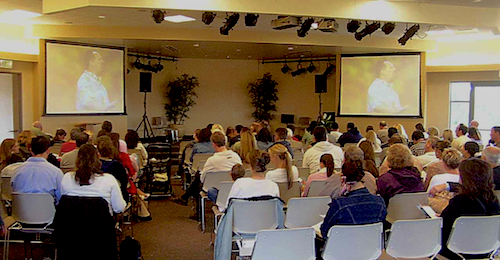
Example of a video overflow room
Larry Osborne, the pastor of North Coast Church in Costa Mesa, Calif., is credited with being the grandfather of video venues, as their church was the first to use video in this way. His vast experience of trial and error led him to underscore an important lesson from creating a simple overflow video room: Adding video and audio to an empty room does not a video venue make. In fact, he noted that when technology was the only thing in the room, people didn’t pay attention and the very essence of the community feel was lost. Larry likened it to putting people in a ‘penalty box’ for showing up late for service and not being able to sit in the main church auditorium.
The solution was to add people and not just technology. From ushers and greeters to worship leaders, the only person not in the overflow room is the teaching pastor on the screen. This is an important lesson for manufacturers and systems integrators to learn as they need to position technology as being in concert with adding staff and volunteers for overflow venues.
Type 2 – Video Cafe Video Venue
Often called a Video Cafe, the worship service format/space/style can be very different from the main service auditorium, but still utilize the sermon videotaped (or live or time-shifted — more on that in a minute) from the main auditorium. The term Video Cafe usually equates with a Starbucks type of setup, but in all reality is just a term that more accurately describes a different venue from the main service.
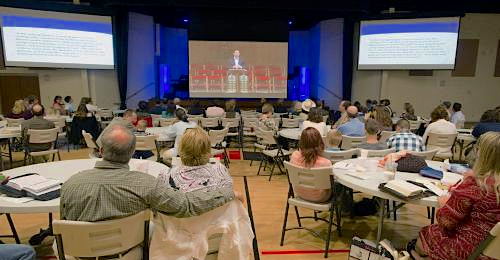
Example of a Video Cafe
A Video Cafe can be on-site (at the same campus but in a different venue) or off-site (at a satellite campus), depending on the vision and intent of the church leadership. Technically, these can utilize single or multiple screens (venue specific as the needs fit) and most have a single tape/disc of switched camera shots recorded during the main venue service. Most will only include the sermon/message portion from the main service, opting for live (and often different) music, or video roll-ins for these alternative worship services. The biggest difference is in the contextualization of the service type.
One of the most interesting technical aspects of video cafes is the opportunity to change the seating and layout of the space to accommodate the various gathering sizes. Thinking very much like a cafe indeed, this level of flexibility often can be applied to the technology, allowing for inventive uses of video screen, and sound systems. For some, this might be a distributed audio system instead of a cluster or line array, allowing for seating to face in multiple directions. Flexibility in the technology and design is paramount in these venues.
Type 3 – Independent Satellite Campus Video Venue
Satellite campuses can take on many forms — from temporary facilities like school gymnasiums or fine art centers to new campuses. Aside from the logistics of set-up and tear-down between temporary venues and new permanent venues, the technology is often utilized much like a Video Cafe, only without the shared facilities.
Having visited dozens of church satellite campuses, I’m convinced that the ultimate (and, unsurprisingly, most expensive) format includes a multi-screen, multi-source approach. In this setup, two (or more, as the venue needs demand) side screens provide the IMAG feed.
Defining IMAG – The use of close-up and medium (*mid-leg to waist-up) camera shots used to visually engage those seated far from the platform. In video venues, close IMAG camera shots are used on the side screens, while a larger center screen shows a locked-down (*doesn’t move to follow any action) shot of the main stage area, covering an area slightly taller than the main teaching pastor, often without panning the camera to follow. The end effect is a life-sized person on this center screen ‘walking around’ on the stage while the side screens capture the up-close IMAG.
It was North Point Church in the Atlanta area that started out using high definition video for their lock-down camera projected onto a center screen (borrowing an HD camera from NASA, no less). Since that time, many churches have implemented HD video and had stunning success with what I call the “suspension of disbelief.” What happens is that two sources — one recorded from the main campus IMAG switcher and one recorded directly from the center locked-down camera — are routed to the screens. The IMAG feed goes to the side screens and the center camera video is sent exclusively to the center screen (which drops down after the music is concluded). They are synchronized with Time Code and play back in perfect sync.
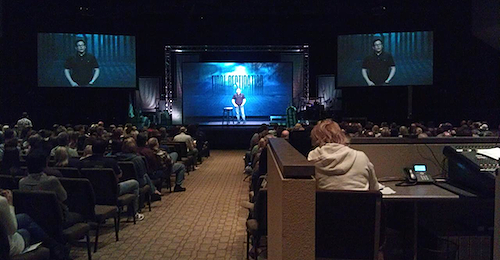
Example of a very large center screen with a projected pastor (he’s about 8 1/2 feet tall on the screen, but not to the eye) that provides the suspension of disbelief for the viewer
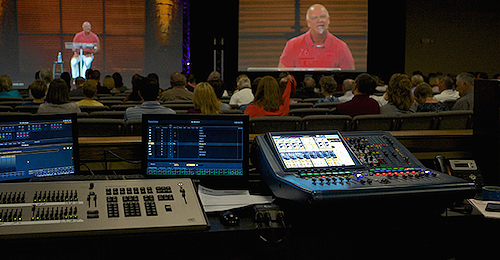
Example of a center screen with a ‘larger-than-life’ teaching pastor sitting on a stool.
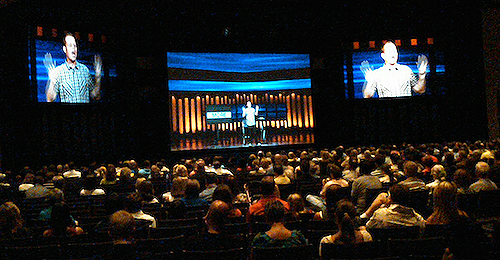
Example of a center screen dropped to the stage floor, utilizing a locked-down center camera shot from the main auditorium.
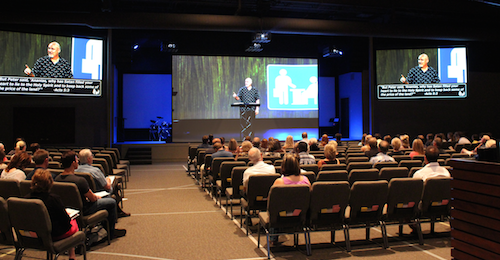
Notice how people on the left side look across to the right screen (which is squared to them) and how even the people in the middle largely watch the close-up side screens.
Example of a very large center screen with a projected pastor (about 8 1/2 feet tall on the screen) that provides the suspension of disbelief for the viewer.
The end result: the audience watches the tight shots (IMAG) on the side screens (non-HD) while they see the main speaker/teacher in their peripheral vision. Because people see a “life-sized” version of the person on the stage (in HD), they quickly forget that it’s not real for two important reasons:
- The HD image quality is far superior to standard NTSC video, resulting in a more life-like version on the center screen.
- The physical spacing between the side screens and the center screen allow your mind to believe that the center screen is the ‘real thing,’ especially if it’s either hung low enough to be near/at the stage or it’s an ascender screen that comes up out of the stage (see the four photos above).
I’m often asked why I’d use SD video on the side screens when HD looks so much better. There’s my answer above, of course, by the truth is that an HD camera with good glass and in good lighting will still produce beautiful SD downconverted video over SDI. Most people wouldn’t notice the difference of live video SD being “less pretty” without a side by side comparison (which wouldn’t happen since the center screen would never show the same image). The suspension of disbelief is the point here.
Type 4 – Interactive Satellite Campus Video Venue
The most difficult of the four types of video venues, by far, is the interactive satellite campus video venues. The technology required to connect — in real-time — campuses spread out by miles is not inexpensive or easy to manage. But, for the church willing to make this leap, the results can be amazing.
The trick here is to have a live audio and video backbone (over dark fiber, microwave or satellite), and enough channels of audio, video and communications (such as Clear Com), as well as the necessary bandwidth to do it all in real-time. It’s usually done over dark fiber, with direct connections made through a dark fiber backbone (point-to-point or point-to-multi-point) so that bandwidth is never an issue. It’s very expensive (think hundreds of dollars per mile, per month).
Often, though, because video is bandwidth-intensive, some systems integrators will compress the video to reduce the file size during transfer. However, remember that the whole point of that center screen was to make it life-like (hence, the use of HD video). So, if the HD signal needs to be compressed to make it fit over a connection, the end result can be less-than-HD video quality, which negates the point of HD in the first place.
Other than that, just the sheer logistics, staff and volunteers necessary to pull this off is staggering. I know of one church in Florida doing this, going so far as to share the mix between three campuses in real-time, such that the FOH engineer at each campus can pull in the vocals/instruments from any of the other campuses for their own mix. This requires incredible planning and logistics to pull off, and I’m not personally sure this is something I’d ever want to do. But… it can be done.
Conclusions for Manufacturers and Integrators
This opportunity numbers in the thousands, as the shift to video venues and satellite campuses is happening in both traditional churches and more contemporary houses of worship. The key considerations from a vendor perspective include:
- If you’ve not yet done it, build out a House of Worship section on your website. Make it easy and obvious for churches to find solutions that fit their context using your technologies.
- Offer video venue options that align with the four kind of video venues above. Give churches options and consider the limitations and opportunities present in each kind of venue.
- Don’t push products — offer solutions. Nothing turns a church off from a potential sale faster than feeling like you’re trying to push things on them that they don’t need. Honesty and forthright descriptions for each solution go a long, long way in the H.O.W. market.
- Demonstrate your expertise by speaking to their pain points and solving problems they haven’t even yet considered. Don’t talk down to them; simply talk with them as if you’re just waiting for them to join the conversation.
How should manufacturers and systems integrators make the most out of the explosive video venue market? Share your views and links in the comments below.




